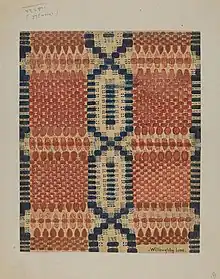
Willoughby Ions (1881–1977) was an American composer, artist, poet, dramatist, designer, and suffragist.
Born Estelle de Willoughby Ions in New Orleans, where her mother . She was married twice.[1] At the age of 4, her family settled in Richmond, Virginia, on family land called Innisfail Farm. Her grandmother was a student of Turner, and gave Ions her first training in art. She never attended any formal schooling.[2]
She was listed as living in Washington DC in 1913 copyright entries. In 1916 she moved to Greenwich Village in New York City and started a career as a costume and textile designer[3]. She designed for Bonwit Teller and achieved some success as the original designer of the hostess gown.[4][2]
In the 1930s she moved to Fairfax, Virginia and became ran the Fairfax Gallery, which taught art classes to local children, and held exhibitions of their work. This led to her associations with the Federal Art Project in Virginia, and contributions to the Index of American Design.
She was a member of the Equal Suffrage League of Virginia.[5] After her cousin Adèle Clark's partner Nora Houston died, Ions left New York and was Clark's partner.[1][4] In New York in the 1910s, she socialized with Sokei-an.[6]
As an artist and designer, Ions worked in a wide variety of styles and media. She created costume designs for a Provincetown production of Lawrence Langner's Pie.[7] Ions and Adèle Clark helped prepare the transcriptions of Ora Canter's contributions to folklorist Richard Chase's 1956 book American Folk Tales and Songs.[8] In 1941 she produced a series of hand-painted plates honoring Stephen Foster.[9][10] She created batik gowns, stained glass art, murals, painted tapestries, and children's toys.[11][12]
Some of her artworks are held at the National Gallery of Art.[13] Her papers are held at the Virginia Historical Society.[1] In 1964, she was interviewed as part of an oral history project by the Archives of American Art.[14]
Selected works
References
- 1 2 3 "Finding Aids for Manuscripts & Archives: Goodman Family". Virginia Museum of History and Culture. 12 February 2002. Retrieved 5 March 2023.
- 1 2 "Oral history interview with Willoughby Ions, 1964 Mar. 11 | Archives of American Art, Smithsonian Institution". www.aaa.si.edu. Retrieved 2024-01-15.
- ↑ "Shoppers' & Buyers' Guide". Vanity Fair: 16. April 1923.
- 1 2 Marschak, Beth; Lorch, Alex (2008). Lesbian and Gay Richmond. Arcadia Publishing. pp. 14–16. ISBN 978-0-7385-5368-9 – via Google Books.
- ↑ Bray, Cindy (2013). "The Social and Cultural Elite and the Hidden "Gay" Society". Rainbow Richmond: LGBTQ History of Richmond, VA, 1625-2010. OutHistory. Retrieved 5 March 2023.
- ↑ Milstead, Claudia (2014). Richards, Anne R.; Omidvar, Iraj (eds.). Historic Engagements with Occidental Cultures, Religion, Powers: Perceptions from Europe and Asia. Chapter 11: Shigetsu Sasaki: Zen Vagabond in the United States. New York, NY: Palgrave Macmillan. ISBN 9781137405012.
- ↑ Black, Cheryl (2002). The Women of Provincetown 1915-1922. Tuscaloosa: The University of Alabama Press. ISBN 0817311122.
- ↑ Chase, Richard; Tolford, Joshua, eds. (1971). American folk tales and songs: and other examples of English-American tradition as preserved in the Appalachian Mountains and elsewhere in the United States. Dover books on folklore, folk art, and folk song. New York, NY: Dover Publ. p. 6. ISBN 978-0-486-22692-7.
- ↑ Bingham, Emily (2022). My Old Kentucky Home: The Astonishing Life and Reckoning of an Iconic American Song. New York: Alfred A. Knopf. p. 180. ISBN 9780525520795.
- ↑ Morneweck, Evelyn Foster; Collection, University of Pittsburgh Foster Hall (1944). Chronicles of Stephen Foster's Family. Foster Hall Collection.
- ↑ Wilson, Richard Guy; Butler, Sara A.; American Society of Architectural Historians, eds. (2002). Buildings of Virginia: Tidewater and Piedmont. Buildings of the United States. Oxford: Oxford University Press. p. 281. ISBN 978-0-19-515206-7.
- ↑ "Meeting Notes". Virginia Medical Monthly. 72. 1945.
- ↑ "Willoughby Ions". National Gallery of Art. Retrieved 2020-04-16.
- ↑ "Oral history interview with Willoughby Ions, 1964 Mar. 11". Smithsonian Archives of American Art. Retrieved 2020-04-16.
- ↑ Office, Library of Congress Copyright (1974). Catalog of Copyright Entries: Third series. p. 158.
- ↑ Catalogue of Copyright Entries: Pamphlets, leaflets, contributions to newspapers or periodicals, etc.; lectures, sermons, addresses for oral delivery; dramatic compositions; maps; motion pictures. U.S. Government Printing Office. 1928. p. 2390.
- ↑ Ions, Willoughby (December 2017). "To The Victors". Air Travel. 1 (4): 186.
- ↑ Office, Library of Congress Copyright (1913). Catalogue of Title-entries of Books and Other Articles Entered in the Office of the Librarian of Congress, at Washington, Under the Copyright Law ... Wherein the Copyright Has Been Completed by the Deposit of Two Copies in the Office. U.S. Government Printing Office. p. 1888.
External links